Slavery in Colombia
Slavery was practiced in Colombia from the beginning of the 16th century until its definitive abolition in 1851. This process consisted of trafficking in people of African and indigenous origin, first by the European colonizers from Spain and later by the commercial elites of the Republic of New Granada, the country that contained what is today Colombia.
.jpg.webp)
Indigenous slavery
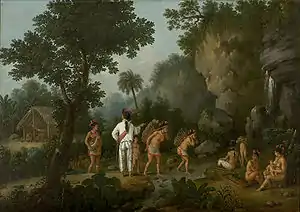
The enslavement of indigenous peoples in what is now Colombia began with the colonization of the country by the Spanish in the early 16th century, and with the creation of the Viceroyalty of New Granada in 1717. With the advance of the Conquistadors, the defeated indigenous peoples were subjected to slavery as prisoners of war, as was the Spanish custom.[1] For example, Gonzalo Jiménez de Quesada, distributed some eighteen thousand conquered prisoners among its captains and soldiers. This process would continue without any state intervention or legal justification until the expedition of the llamas Laws of Burgos by the Spanish crown, this eliminated the slavery of the indigenous peoples in 1512 de jure. The legal status of the conquered American population would be improved again by the calls New Laws of 1542, which would establish new protections for these people.
These protections, however, this should not be construed as an abolition de facto of slavery by Amerindians. Among the Spanish colonizers of that time, an aphorism arose, "the law is obeyed, but it is not followed", in reference to the contempt of the laws issued in Europe.[3] The slavery of the native peoples would continue on the margin of the law, with the conquered being frequently subjected to the same treatment by the Spanish.
Beyond the informal practice of slavery, forced labor would continue even within the framework of the law, with institutions known as the mita and the encomienda. The new regulations as well as the Burgos laws still contemplated forced labor and, although this was not formally the very institution of slavery, it was not far from the slave trade. The mita established labor quotas that the native population had to fulfill as a tribute according to the assignment made by the corregidor. The encomienda was a form of clientelism in which the indigenous people were forced to pay an encomendero the services supposedly provided by the same. The main service that the encomendero had to render as contemplated by colonial legislation was evangelization, but even in this there was negligence. For example, around the 16th century, there was only one encomendero de tapia church in all Santa Fe de Bogotá. Meanwhile, in Tunja, the encomenderos not only neglected their duty to educate but actively sabotaged it, strongly opposing indigenous people learning to read and write.
The application of New Laws of 1542 was suspended and with it his intention to leave the private encomenderos without power. Towards October 1545 the Malina Law repeal was intended to weaken the encomenderos, again allowing the viceroys and governors to establish new encomiendas. This reached a new dimension with the colonization of the New World, since the subjugated native population was insufficient for the exploitation of natural resources and their number was reduced either because of the spread of disease or death from abuse by Europeans. Thus the massive trafficking of African slaves to the provinces that would be the New Granada would begin only after the indigenous population was decimated, beginning in the second half of the 16th century. This trafficking occurred through the so-called licenses, a kind of contract with the state in which the crown authorized the slave trade to the colonies in exchange for a tax contribution.
The slave trade was morally justified under the idea that the slave received the "invaluable" evangelizing work of his master, and that the Christian principle of equality referred to equality in the hereafter and the superiority of the white man in the present. This did not prevent slaves from being transported in subhuman conditions; the journey from Africa to America lasted about two months and was carried out on disease-ridden ships, with poor or no ventilation, and overcrowded.
African slavery
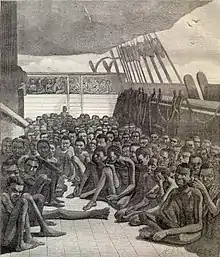
The Iberian slave trade in Africa began with the Portuguese, who transported prisoners to the Madeira Islands and the Azores. Through the Treaty of Alcáçovas, in 1479 the Kingdom of Castile recognized the Portuguese primacy in the African slave trade, which would make them the main providers of enslaved labor for centuries to come. This reached a new dimension with the colonization of the New World, since the subjugated native population was insufficient for the exploitation of natural resources and their number was reduced day by day either because of the spread of disease or death from abuse by Spaniards. Thus the massive trafficking of African slaves to the provinces that would be the Viceroyalty of New Granada would begin only after the indigenous population was decimated, beginning in the second half of the 16th century. This trafficking occurred through licencias, a kind of contract with the state in which the crown authorized the slave trade to the colonies in exchange for a tax contribution.
The slave trade was morally justified under the idea that the slave received the "invaluable" evangelizing work of his master, and that the Christian principle of equality referred to equality in the hereafter and the superiority of the white man in the present. This did not prevent slaves from being transported in subhuman conditions; the journey from Africa to America lasted about two months and was carried out on disease-ridden ships, with poor or no ventilation, and in overcrowded conditions.
Ethnic origins
The first Portuguese conquerors to reach the African coasts had a fairly direct approach to enslaving the natives, depending on war expeditions in which they kidnapped the natives; however the process was cumbersome and difficult, so it was eventually replaced by trading posts, in which manufactured products were exchanged by local leaders in exchange for captured slaves.
The bulk of African slaves arriving in the New World was taken from the west African coasts, understood as the space between the Senegal and Cuanza rivers. Determining the ethnic origin of slaves is complex since the records of the time come from Europeans interested in identifying the port of origin and not in making any type of assessment ethnographic. Thus, the various researchers who approach the question of the origins of Afro-Colombian slaves often have no choice but to group their origin into larger regions, often divided into three. Luz Adriana Maya identifies these as: Sudano-Sahelian, the tropical forest and the equatorial rainforest; John Thornton identifies the three regions as: Upper Guinea, Lower Guinea and the Angola region. These regions do not comprise a single town and include great diversity among them.
The western Sahel region is home to ethnic groups such as the Fulani, Mande and Songhai. The region was home to the largest empires in Sub-Saharan Africa, the Empire of Ghana, Empire of Mali and Songhai Empire; The latter two would become a direct part of the slave trade and collapse during it. The two later empires would be Muslim, which would influence not only their dominant ethnic groups but other peoples who would arrive in chains at the ports of Cartagena de Indias such as the Balanta, Bijagós, Diola, Nalu and Susu.
In the Gulf of Guinea region, peoples can be divided into two macro-groups, the Kwe peoples and the speakers of Volta-Niger languages. This region was dominated by smaller states like the Ashanti Kingdom as well as the city states of Ife and Benin. It is the origin of peoples such as the Yoruba, Igbo and Ashanti people. This region represents the origin of several Afro-Caribbean religions still practiced in Colombia such as Santeria, which has its origin in the Yoruba religion.
In the southernmost region between the Congo river delta and present-day Angola, the great majority of the peoples were of Bantu origin, mainly from speakers of the Kikongo and Kimbundu. The region included states such as the small Lunda Empire and the great Kingdom of Kongo, whose king Afonso I unsuccessfully attempted to stop the slave trade from his domain by sending correspondence to John III of Portugal speaking of the "corruption and depravity" of European slavers who depopulated their country. He also sent emissaries to deal with the pope, but these were intersected by the Portuguese upon landing in Lisbon.[15]
On the Caribbean coast
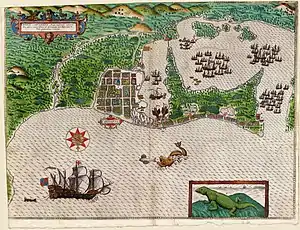
Cartagena de Indias was the main port of entry of slaves into the country during the colonial period and during its highest boom it turned out to be the most lucrative business in the city. By 1620 the city had 6,000 inhabitants, of whom 1,400 were slaves of African origin, by 1686 the number of slaves had increased to 2,000.[16] In the census carried out between 1778 and 1780 it was determined that the slave population represented 10% of the population in Santa Marta Province and 8% of Cartagena Province.[17]
The use of slave labor turned out to be essential for the economy of Cartagena Province, both in urban and rural areas. With the death of the vast majority of the native population, the work of the Africans became highly relevant. Although during the seventeenth century slave labor was used in both agriculture and livestock, eventually it became concentrated around only the latter since agriculture is seasonal and therefore less profitable for the slave owner who wanted to minimize the hours in which the slave did not work.[18]
Inside the cities, slavery gained a function not only of production but of status, all the houses of prosperous Spaniards in Cartagena and Mompós were endowed with black servitude, which served as a sign of opulence.[18] These slaves were traded during the 17th century for a value between 200 and 400 silver pesos each.[19]
The system of production with slave labor required a constant influx of new slaves, since the population of African origin had negative growth rates in the New World. This was due to various factors such as the number of men exceeding that of women by a factor of 5 to 1 because they were considered more productive, as well as the high death rate among workers. This required the constant influx of new "Bozales" slaves (born in Africa).[20]
Slavery in the Cartagena province began to decline in the 18th century. During the republican era the institution entered into a true decline, mainly in rural areas where the current system of production ceased to be replaced by cheap mestizo labor. In urban areas slavery managed to maintain its relevance because it was more linked to the exhibition of status than to modes of production, so it continued to be a relevant system until its abolition in the 19th century.[18]
On the Pacific coast
The first attempts at mining using slaves of African origin in the Pacific coast of New Granada occurred during the 17th century. However, these attempts were very limited and mostly unsuccessful due to the great difficulties that the Spanish had in subjugating the native populations. Large mining operations, and with them the massive trafficking of African slaves to the west coast, would not begin until the last two decades of the 17th century.
The vast majority of the African slaves that would eventually reach the Pacific entered through the port of Cartagena de Indias; in the Pacific they were marketed for a value of about 300 silver pesos if they were born in Africa, and between 400 and 500 if they were born in the New world. [22] From analysis of documents of the time, it seems that more than half of the slaves who arrived in Chocó were of Kwa origin, mainly from the Akan and Ewe, there were also important minorities of Mandé, Gur speakers and Kru.[23]
The Pacific coast was the colonial area with the highest percentage of slave population in New Granada territory. In the 1778-1780 census it was found that slaves in Chocó constituted 39% of the population, 38% in Iscuandé, 63% in Tumaco, and in Raposo (Modern day Buenaventura), an extraordinary 70%.[24]
These slaves destined for mining production were a vital component in the Pacific Region. Between 1680 and 1700 Popayán was the source of 41% of the gold production in New Granada.[25]
Rebellions
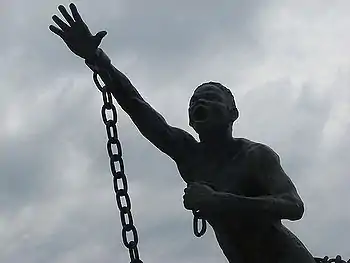
Indigenous rebellions
The first to oppose the imposition of forced labor by Europeans were indigenous peoples. During the 16th century there were rebellions of the Paeces, Muzos, and Yariguis. The Chinantos rebelled against the town of San Cristóbal, while the Tupes did the same in Santa Marta. However, the Pijaos were the most successful in this regard, managing to stop work in the mines of Cartago and Buga, successfully interrupting communication with Popayán and Peru, and killing the Governor of Popayán Vasco de Quiroga. The war waged during the first decade of the 17th century would end with a victory for the Europeans, who would be rewarded for their service in the form of encomiendas.
African rebellions
African slaves frequently rebelled against their masters, either through the practice of cimarronaje or through armed rebellion. In Santa Marta in 1530, just five years after the city was built, a slave rebellion destroyed the town. The city would be rebuilt only to suffer a new rebellion in the 1950s.
Although it was certainly possible for an individual slave to flee their masters and go unnoticed among the free black population of a large city, it was a precarious situation in which the fugitive was at constant risk of discovery; therefore it is natural that many acts of flight were organized and directed towards communities of Maroons in which they could find security with those of their own class.[28]
Not all rebellion activities ended in flight, in several cases the threat of revolt was used as a method within collective bargaining. In 1768 in the province of Santa Marta a group of slaves wounded a foreman whom they accused of ill-treatment, when their master sent a couple of white men to subdue them, the blacks killed one of the whites. Far from being intimidated, the rebels gave their master an ultimatum, if he did not agree to their demands they would burn down the entire estate and escape to live with the "brave Indians." Without further remedy, the master accepted their demands, swearing to forgive them for the revolt, stopping the mistreatment and agreeing that if the slaves were ever sold this should be done collectively so as not to divide the families. The owner also agreed to provide the workers with a good quantity of tobacco and brandy as compensation for the abuses.[29] Similar incidents occurred in Neiva in 1773 and Cúcuta in 1780, in which the slaves had reached a sort of agreement with the Jesuit priests in which their treatment was more similar to that of free peasants in a sharecropping, in which they were remunerated for their crops and granted holidays. When a new master refused to uphold what the slaves considered their customary rights, they did not hesitate to go into open rebellion and demand that the colonial government authorities recognize their rights.[30]
On the other hand, it is important to recognize that the resistance strategies of the black women enslaved during the colonial period were aimed at confronting colonial power by resorting to judicial demands.[31]
However, the most famous slave rebellion in New Granada was undoubtedly that of the slaves of San Basilio de Palenque, led by Benkos Biohó, the rebellion was so successful that on August 23, 1691 the king of Spain was forced to issue a certificate ordering the general freedom of the Palenques and their right to land.
At the end of the 17th century, the colonial authorities tried again to start a great campaign against the Maroon Palenques, but despite succeeding in destroying some villages, the entire campaign turned out to be a failure, since the blacks managed to preserve their freedom and simply moved south.[28]
Cimarronaje would continue until the 19th century with the abolition of slavery, after which the former slaves would exercise new forms of resistance seeking to retaliate against their former masters. Blacks roamed the fields, tearing down fences, raiding property, and punishing conservatives with their whips; This period was named by the President José Hilario López as "The democratic frolics."[33]
Abolition
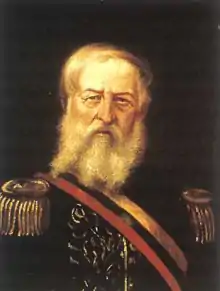
The process of manumission of slaves occurred to some extent throughout the history of the colony, but the question of abolishing slavery as an institution did not begin to take relevance until the Napoleonic invasion of Spain; a context in which the need to abolish slavery was raised in the Iberian courts since 1809 in order to prevent "slaves from seeking and even achieving it by violent and coercive means". Antonio Villavicencio was a proponent of freedom of wombs, however his views were not heeded by the Spanish crown.[34]
During the war of independence of Colombia, Simón Bolívar introduced in 1816 the idea of granting freedom to slaves who participated in the independence cause.[34] This process was controversial, because the landowners who depended on slaves both for work and social status staunchly opposed the liberation process.
In order to compromise with the demands of the slavers who demanded that their "property" be respected, José Félix de Restrepo managed before the Congress of Cúcuta to decree the freedom of wombs, which declared as free the children of slaves born as of July 21, 1821. The law established for the masters the obligation to "Educate, clothe and feed the children [...] but they as a reward will have to compensate the masters of their mothers for the expenses incurred in their upbringing, with their works and services, which they will provide until the age of 18.”[34] The slave trade was definitively prohibited in 1825.
Although the freedom of young slaves should have started on July 21, 1839, the process was largely delayed by the War of the Supremes, which was fought from 1839 to 1842. After the war and under pressure of the masters, a new law of May 29, 1842, extended the dependence on slaves for another 7 years through what was called apprenticeship. In other words, the 18-year-old slaves would be presented to the mayors who should have them serve their former master or someone else who could "educate and instruct" them in a trade or profession. In this way slavery was extended, while those who refused to participate were recruited into the national army.[34]
The inefficiency of the manumission, as well as the corruption of officials and landowners who continued with the slave trade ignoring the law caused great discontent among the so-called Democratic Societies (liberal associations of artisans). This great political upheaval, coming from both the artisans and the slaves themselves, led the President José Hilario López to propose absolute freedom. Finally, the Colombian Congress dictated the law of May 21, 1851, by means of which the slaves would be free as of January 1, 1852 and the masters would be compensated with bonds.[34]
Even so, in many places the masters refused to let the slaves go in a peaceful way, this led to the civil war of 1851, which began with an insurrection in Cauca and Pasto headed by the Conservative leaders Manuel Ibáñez and Julio Arboleda with the support of the Ecuadorian government. In Antioquia the rebellion broke out at the hands of conservatives led by Eusebio Berrero. The war would end in four months with the liberal victory and the final liberation of the slaves.[35]
From all this it can be concluded that the abolition of slavery that occurred during the republic was a gradual process. This can be verified when seeing how the percentage of the enslaved population was in constant decline throughout the republican period until the definitive abolition of the institution:[34]
| Year | Population (#) | Slaves (#) | Percentage (%) |
|---|---|---|---|
| 1778 | 798,956 | 62,547 | 7.82% |
| 1825 | 1,129,174 | 45,133 | 4.00% |
| 1835 | 1,570 854 | 37,547 | 2.39% |
| 1843 | 1,812,782 | 25,591 | 1.41% |
| 1851 | 2,105,622 | 15,972 | 0.76% |
See also
References
- Miguel Angel 2012.
- López 2019.
- Hochschild 1999, p. 33-34.
- Meisel Roca 1980, p. 242.
- McFarlane 1991, p. 54.
- Meisel Roca 1980, p. 243.
- Meisel Roca 1980, p. 248.
- Meisel Roca 1980, p. 251.
- de Friedemann 1974, p. 96.
- Granda Gutiérrez 1988, p. 73-74.
- McFarlane 1991, p. 55.
- de Friedemann 1974, p. 98.
- McFarlane 1991, p. 57.
- McFarlane 1991, p. 63.
- McFarlane 1991, p. 73-75.
- Vergara Figueroa, Aurora; Cosme Puntiel, Carmen Luz, eds. (2018). Demando mi libertad [I demand my freedom]. El sur es cielo roto (in Spanish). 16 (1st ed.). Cali, Colombia: Universidad Icesi. doi:10.18046/EUI/Escr.16.2018. ISBN 978-958-8936-36-9. OCLC 1121270926. OL 26778189M.
- Valencia Llano 1998.
- Tovar Pinzón 1994.
- Vélez Ocampo 2005.
Bibliography
- Navarrete, María Cristina (2005). Genesis and development of slavery in Colombia in the 16th and 17th centuries. Universidad del Valle. ISBN 9789586703383. Retrieved 20 March 2019.
- Navarrete, María Cristina (2008). San Basilio de Palenque: memory and tradition - Emergence and vicissitudes of maroon deeds in the Colombian Caribbean. Universidad del Valle. ISBN 978-9587654189. Retrieved March 20, 2019.
- Ruiz Rivera, Julián Bautista; Navarro García, Luis (1975). Commendation and myth in New Granada in the 17th century. CSIC Press. ISBN 8400041763. Retrieved March 19, 2019.
- Meisel Roca, Adolfo (July 4, 1980). Slavery, Miscegenation and Haciendas in the Province of Cartagena: 1533-1851. Revista Desarrollo y Sociedad. p. 229–277. doi:10.13043/dys.4.2.
- de Friedemann, Nina S. (1974). The black culture of the Ecuadorian and Colombian coast: a model of ethnic adaptation (PDF). Colombian Journal of Anthropology. 18. p. 75–115. Retrieved March 22, 2019.
- Granda Gutiérrez, Germán (1988). The slaves of Chocó. Its African origin (18th century) and its possible linguistic impact on the Spanish of the area (PDF). Thesaurus: newsletter of the Caro y Cuervo Institute. p. 65–80. Retrieved March 22, 2019.
- McFarlane, Anthony (1991). Cimarrones and Palenques in Colombia: 18th century (PDF). History and space. Retrieved March 22, 2019.
- Tovar Pinzón, Hermes (November 1994). Manumission of slaves in Colombia, 1809-1851, Social, economic and political aspects. Credential History. Retrieved March 22, 2019.
- Vélez Ocampo, Antonio (2005). Cartago, Pereira, Manizales: historical crossroads. Papiro. pp. War of 1851. ISBN 9588236371. Archived from the original on 2011-07-23. Retrieved 22 March 2019.
- Valencia Llano, Alfonso (1998). General José Hilario López, a liberal civilist. Credential History. Retrieved March 22, 2019.
- Hochschild, Adam (1999). The Ghost of King Leopold. Boston: Houghton Mifflin. ISBN 978-0-618-00190-3.
- Miguel Angel (March 29, 2012). Slavery of indigenous and black people in colonial times. Weekly Magazine. Retrieved March 19, 2019.
- López, Clara (26 February 2019). Objecting the law of the JEP goes against the Constitution. Magazine Week. Retrieved March 19, 2019.